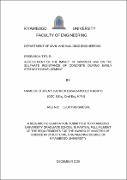| dc.description.abstract | Sulfates are detrimental to the structural integrity of concrete throughout its service
life. In the project for the construction of the overhead transmission line grid for power
evacuation from the Karuma Hydro Power plant, aggressive levels of sulfates were
encountered along Karuma – Lira 132kV Transmission Line. This necessitated use of
Sulfate Resisting Cement (SRC) in foundations to counter sulfate attack. Sulfate
Resisting Cement is twice as expensive as Ordinary Portland Cement (OPC) in Uganda
and may only be available on a minimum special order of 200 tons. Based on the above
the study was therefore aimed at evaluating the impact of sawdust ash on the sulphate
resistance of concrete during early strength development. A total of 384 concrete cubes
of 4 designed mixes were used in two different sulphuric acid solutions of differing
concentrations to simulate sulphate attack on concrete. Cubes were exposed to sulfate
attack for 28 days in sulphuric acid solutions in the early stages of hardening (i.e., at
the age of 6, 24 and 72 hours) and in the later stage of hardening (i.e., aged 28 days).
SDA dosages used to replace part of the OPC were 0%, 5%, 10% and 15%. It was
observed that concrete in the early stages of hardening (i.e., age of 6, 24 and 72 hours)
exhibited improved resistance to sulfate attack compared to that in the later stage of
hardening (i.e., aged 28 days). Moderate strength concrete grades (i.e., C16/20,
C20/25) with design cement content less than 18.1% performed better than the higher
strength concrete (i.e., C25/30 and C30/37). The ingress of SO4
2- ions into C20/25-5%
SDA concrete followed a decreasing linear function for concrete cured for 72 hours
before exposure to sulfate attack. A maximum cement replacement of 10% with SDA
as well as partial back filling of foundation concrete after 72 hours of casting is | en_US |

